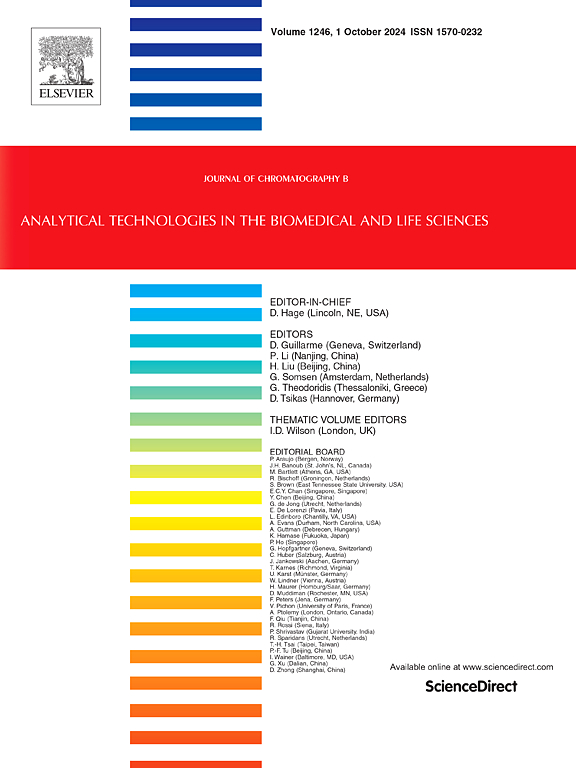Qualitative and quantitative analyses of chemical components in different parts of Marsdenia cavaleriei
IF 2.8
3区 医学
Q2 BIOCHEMICAL RESEARCH METHODS
引用次数: 0
Abstract
Species of the genus Marsdenia have a long history of medicinal use in China, with C21 steroids serving as the principal bioactive constituents. Marsdenia cavaleriei remains an unexplored phytochemical resource, particularly regarding the material basis in different plant parts. In this study, an ultra-high-performance liquid chromatography coupled with quadrupole time-of-flight mass spectrometry (UHPLC-Q-TOF/MS) analytical method was developed to thoroughly characterize the chemical constituents of this plant. A total of 68 compounds were identified, 48 of which were tentatively identified as novel. Principal component analysis (PCA) and orthogonal partial least squares discriminant analysis (OPLS-DA) were employed to screen 18 potential chemical markers, elucidating compositional differences across various plant parts. Quantification of Tenacissoside H was conducted using ultra-high-performance liquid chromatography with charged aerosol detection (UHPLC-CAD), revealing its absence in the leaves. The average content of Tenacissoside H in the roots (0.281 %) exceeded that in the stems. A semi-quantitative analytical method was developed under identical gradient conditions with inverse gradient compensation. The relative standard deviation (RSD) of the average response factors for five references was 2.46 %. The semi-quantitative analysis of nine primary C21 steroids showed that Tenacigenoside K and Tenacissoside A were most abundant in the leaves, Tenacissoside A and Marsdenoside H dominated in the stems, and Marsdenoside H and Tenacissoside D were the most prevalent in the roots. This study presents a comprehensive approach for qualitative and quantitative analysis, thereby enhancing our understanding of the chemical composition of M. cavaleriei across its various parts and providing a foundation for its broader application.
马尾草不同部位化学成分的定性与定量分析
马蹄草属植物在中国具有悠久的药用历史,其主要生物活性成分为C21甾体。马尾草是一种尚未开发的植物化学资源,特别是在不同植物部位的物质基础方面。本研究建立了一种超高效液相色谱-四极杆飞行时间质谱(UHPLC-Q-TOF/MS)分析方法,对该植物的化学成分进行了全面表征。共鉴定出68个化合物,其中48个初步鉴定为新化合物。采用主成分分析(PCA)和正交偏最小二乘判别分析(OPLS-DA)筛选了18个潜在的化学标记,阐明了植物不同部位的成分差异。采用超高效液相色谱荷电气溶胶检测法(UHPLC-CAD)对天冬苷H进行定量分析,发现其在叶中不存在。根中天冬苷H的平均含量(0.281%)高于茎中。在相同梯度条件下,建立了一种梯度逆补偿的半定量分析方法。5个参考文献的平均反应因子的相对标准偏差(RSD)为2.46%。对9种初级C21甾体进行半定量分析,结果表明,天冬苷K和A在叶片中含量最多,茎中以天冬苷A和H含量最多,根中以天冬苷H和D含量最多。本研究提供了一种综合的定性和定量分析方法,从而提高了我们对卡瓦莱韦各部分化学成分的了解,为其更广泛的应用提供了基础。
本文章由计算机程序翻译,如有差异,请以英文原文为准。
求助全文
约1分钟内获得全文
求助全文
来源期刊

Journal of Chromatography B
医学-分析化学
CiteScore
5.60
自引率
3.30%
发文量
306
审稿时长
44 days
期刊介绍:
The Journal of Chromatography B publishes papers on developments in separation science relevant to biology and biomedical research including both fundamental advances and applications. Analytical techniques which may be considered include the various facets of chromatography, electrophoresis and related methods, affinity and immunoaffinity-based methodologies, hyphenated and other multi-dimensional techniques, and microanalytical approaches. The journal also considers articles reporting developments in sample preparation, detection techniques including mass spectrometry, and data handling and analysis.
Developments related to preparative separations for the isolation and purification of components of biological systems may be published, including chromatographic and electrophoretic methods, affinity separations, field flow fractionation and other preparative approaches.
Applications to the analysis of biological systems and samples will be considered when the analytical science contains a significant element of novelty, e.g. a new approach to the separation of a compound, novel combination of analytical techniques, or significantly improved analytical performance.
 求助内容:
求助内容: 应助结果提醒方式:
应助结果提醒方式:


